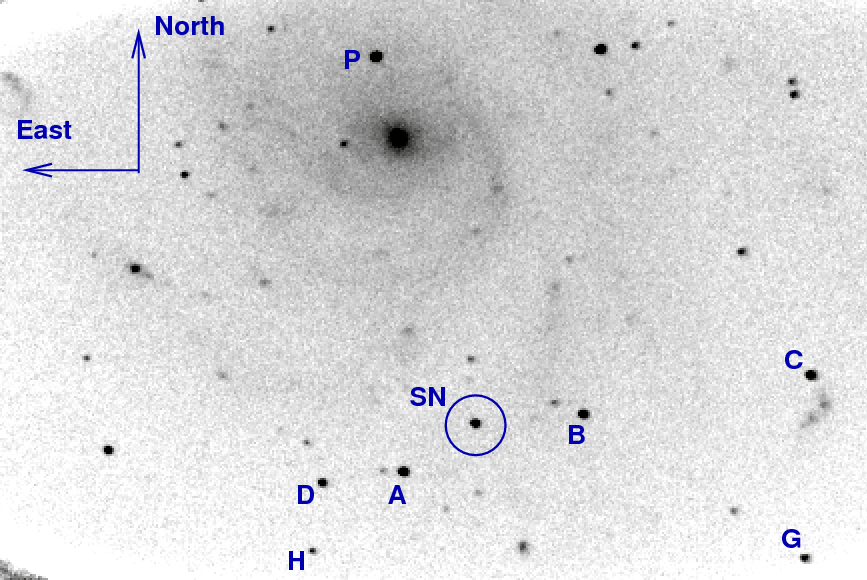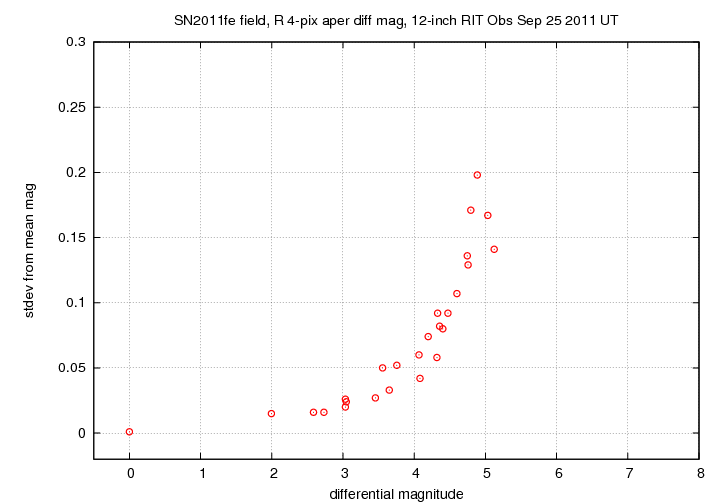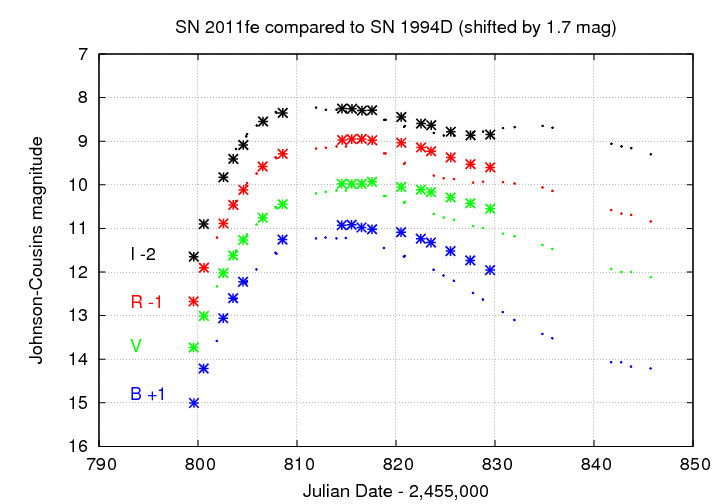
On the night of Sep 24/25, 2011, I observed the newly discovered supernova known as PTF 11kly = SN 2011fe in the galaxy M101.
The setup was:
Notes from the night
This is a chart of the field of SN 2011fe, based on a stack of five R-band images. The field of view is about 10 by 8 arcminutes.

The marked objects appear in a list of comparison stars with magnitudes in BVRI, created by the AAVSO. You can find the original at the AAVSO web site; go to the Variable Star Plotter (VSP) area. I've made a simplified ASCII version of the catalog below, or you can look at the AAVSO's original version in a local copy.
#AUID RA. Dec. Label U B V Rc Ic J H K Comments # Label RA Ra(deg) Dec Dec(deg) ID U B V R I 000-BKD-527 14:03:49.86 [210.95775d] 54:09:05.8 [54.15161d] 117 x - 12.268 (0.057)29 11.735 (0.040)29 11.359 (0.048)29 11.006 (0.054)29 - - - 000-BKD-528 14:04:21.68 [211.09033d] 54:19:22.4 [54.32289d] 119 x - 12.572 (0.068)29 11.948 (0.047)29 11.528 (0.056)29 11.134 (0.063)29 - - - 000-BKD-529 14:02:00.79 [210.50330d] 54:23:15.8 [54.38772d] 128 x - 13.553 (0.062)29 12.751 (0.031)29 12.253 (0.045)29 11.788 (0.056)29 - - - 000-BKD-530 14:01:55.32 [210.48050d] 54:16:21 [54.27250d] 131 x - 13.540 (0.064)29 13.094 (0.044)29 12.716 (0.051)29 12.361 (0.056)29 - - - 000-BKD-531 14:02:02.00 [210.50833d] 54:20:43.9 [54.34553d] 133 x - 14.188 (0.094)29 13.291 (0.057)29 12.772 (0.074)29 12.287 (0.088)29 - - - 000-BKD-532 14:01:49.79 [210.45746d] 54:23:02.7 [54.38408d] 134 x - 14.187 (0.047)29 13.436 (0.033)29 12.970 (0.049)29 12.534 (0.061)29 - - - 000-BKD-533 14:03:13.67 [210.80696d] 54:15:43.4 [54.26205d] 138 A - 14.699 (0.091)29 13.801 (0.046)29 13.230 (0.062)29 12.698 (0.074)29 - - - 000-BKD-534 14:02:54.17 [210.72571d] 54:16:29.5 [54.27486d] 140 B - 14.557 (0.107)29 13.991 (0.074)29 13.581 (0.078)29 13.197 (0.083)29 - - - 000-BKD-535 14:02:29.54 [210.62308d] 54:16:55.2 [54.28200d] 141 C - 14.959 (0.102)29 14.100 (0.045)29 13.598 (0.063)29 13.130 (0.077)29 - - - 000-BKD-536 14:02:31.15 [210.62979d] 54:14:03.9 [54.23442d] 146 G - 15.158 (0.078)29 14.605 (0.029)29 14.204 (0.061)29 13.828 (0.082)29 - - - 000-BKD-540 14:01:50.86 [210.46191d] 54:16:08.1 [54.26892d] 149 x - 15.373 (0.010)29 14.925 (0.000)29 14.635 (0.006)29 14.361 (0.008)29 - - - 000-BKD-538 14:03:23.74 [210.84892d] 54:14:32.6 [54.24239d] 155 H - 16.015 (0.042)29 15.475 (0.000)29 15.133 (0.046)29 14.811 (0.065)29 - - - 000-BKD-539 14:03:05.64 [210.77350d] 54:17:26.2 [54.29061d] 162 x - 16.776 (0.091)29 16.177 (0.000)29 15.640 (0.079)29 15.140 (0.112)29 - - - #Report this sequence as: 5249bgj in the chart field of your observation report. This table is for a 0.25000° fov around PTF11KLY, RA: 14:03:05.81 (210.77421) & Decl.: 54:16:25.40 (54.27372).
I measured the instrumental magnitude of each star with aperture photometry, using a radius of 3 pixels = 4.2 arcseconds in B, and a radius of 4 pixels = 5.6 arcseconds in VRI, and sky defined by an annulus around each star. Following the procedures outlined by Kent Honeycutt's article on inhomogeneous ensemble photometry, I used all stars available in each image to define a reference frame, and measured each star against this frame.
Below is a graph of the scatter in differential magnitude versus magnitude in the ensemble solution for the R-band.

Tests over the past week have indicated that, although stars A, B, C, G and H have photometry from the AAVSO, the best results occur when I discard H. It is significantly fainter than the others, and almost always is an outlier from the photometric solution.
I switched the order of filters for the SN from BVRI to BVIR this evening. When I take twilight sky flats, the order is BVIR, based on the level of sensitivity to the sky brightness. I've noticed over the past few weeks that dust donuts on the R-band twilight flatfield exposures are sometimes shifted relative to the same donuts on R-band SN exposures. I guessed that perhaps the problem was that the filter wheel was rotating one way for the flats -- moving from I-band to R-band -- but a different way for the SN exposures -- moving from V-band to R-band. So, I made the SN exposures occur in the same sequence as the twilight sky flats. It appears to have worked: the corrected R-band exposures on this night look clean.
Applying the color corrections determined on UT Aug 27 to the ensemble photometry of SN 2011fe and the comparison stars in its field, I find the magnitude of SN 2011fe on this night was
Passband JD-2,455,000 Mag +/- ------------------------------------------------- B 829.501 10.96 0.12 V 829.510 10.55 0.06 R 829.529 10.60 0.06 I 829.520 10.85 0.08 -------------------------------------------------
The uncertainties here are dominated by the photometry of the reference stars.
I have reported these measurements to the AAVSO via their WebObs tool ....
You can find a complete set of the RIT Obs measurements by grabbing the file sn2011fe_mags.out. I've plotted our measurements in two graphs. First, the measurements of SN 2011fe so far:

Second, the new SN compared to another Type Ia SN, SN 1994D in NGC4526. I've shifted the SN 1994D measurements in time and in magnitude so that they sort of match the early observations of SN 2011fe.

We are starting to see the rise to secondary maximum in the I-band, as expected.
Last modified 9/25/2011 by MWR.